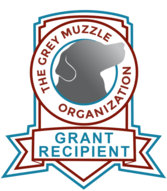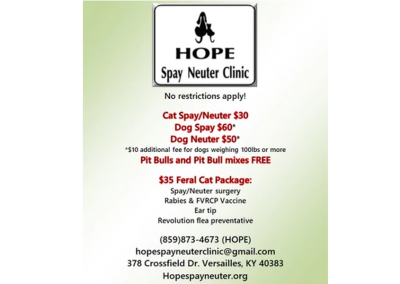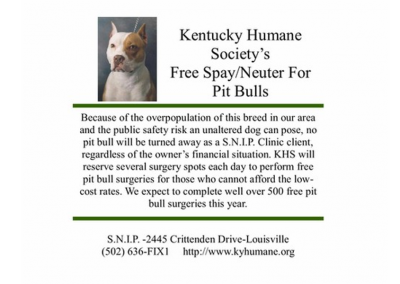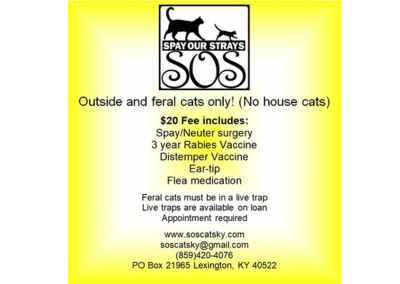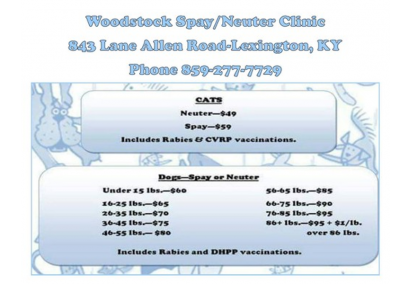Safety Pursuit
Why Spay & Neuter?
It’s good for your pet!
Behavior: An altered pet is much less likely to run away in pursuit of a mate, keeping them safe at home instead of in the road or in competition with others which will lead to fighting and possible injuries. It also eliminates mounting and territory marking in most animals. Spayed females will no longer draw males and she’ll be happier without the physical stress of a heat cycle.
Health: Males neutered before the age of 6 months have a greatly reduced risk of developing prostate tumors, infection and enlargement. Female dogs that are not spayed have a 50% chance of developing mammary tumors (spayed dogs only have a 1% risk). Spaying nearly eliminates the chance of uterine cancers and infections, which are a common cause of death for unaltered females. Without the stress of the sexual drive, your pet will have an overall healthier immune system.
It’s good for you!
Peace of Mind: The nuisances associated with a female in heat are eliminated. You won’t have to worry about the well being of your pet’s offspring. Kittens and puppies can be easy to give away, but once they are grown up or the challenge of taking care of a young pet becomes too much the new owner, will they give it away or take it to the shelter? Will they keep that free kitten/puppy forever and provide it a loving home? Unfortunately many do not.
Financial: The cost of caring for a pregnant female and her litter is many times higher than the one-time fee to have her spayed. An unaltered male will probably roam searching for females and the costs of veterinary care because he was fighting other non-neutered males or the costs of picking your stray dog up from Animal Control are much higher than the one-time payment to have him neutered.
It’s good for all pets!
Most pets in shelters did not end up there because they did anything wrong. Most were not born in the streets. They are often the offspring of cherished family pets, even purebreds. The offspring of intentional litters and those that resulted from the pet getting out that one time are all at risk of ending up homeless when efforts to find enough good homes fail.
Spay/Neuter Programs
Low Cost Resources
Safety Pursuit
Spay & Neuter Assistance Program
Who qualifies for a SNAP voucher?
All Anderson County residents qualify – our voucher is not limited to low-income families, because it is urgent that we reduce the birth of unwanted litters in Anderson County.
Where will my pet be spayed/neutered?
Anderson Animal Hospital and The Animal Clinic accept our vouchers as well as several veterinarians in the surrounding counties.
What does it cost?
Our voucher only covers the cost of the surgery – the veterinarian may charge any vaccinations, office fees, or exam fees when your pet is spayed/neutered.
- Cat neuter = $35.00
- Cat spay = $45.00
- Dog Neuter = $45.00
- Dog Spay (1-40lbs) = $55.00
- Dog Spay (41-70lbs) = $65.00
- Dog Spay (over 71lbs) = $75.00
How do I get a voucher?
Fill out the dog voucher application or the cat voucher application and mail it along with your co-pay (check or money order) to the P.O. Box listed on the application (P.O. Box 448 for dog voucher applications and P.O. Box 494 for cat voucher applications). You will NOT receive your voucher any faster if you bring it to the Adoption Center! Mailing the application to the P.O. Box is the quickest way to get your voucher.
If you need an emergency voucher, please contact our office. Unfortunately, emergency vouchers are not always available!
Please Note: Terms of the vouchers, including whether they will be honored by the participating veterinary physicians, are subject to change at the discretion of the Humane Society and the physicians. If you encounter a problem with you voucher, please contact us.
Why is SNAP so important?
When the program began in 2005, about 1,100 stray, abandoned, or unwanted animals were taken in at the Humane Society. In the years since then, the number has fallen below 800 despite a growth in the county’s population. Spaying and Neutering the pets in Anderson County is part of the solution to keeping cats and dogs safe from the threat of euthanasia due to overpopulation.
